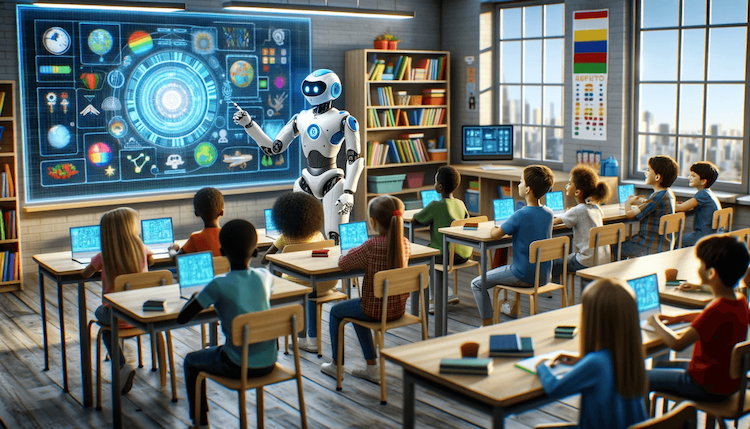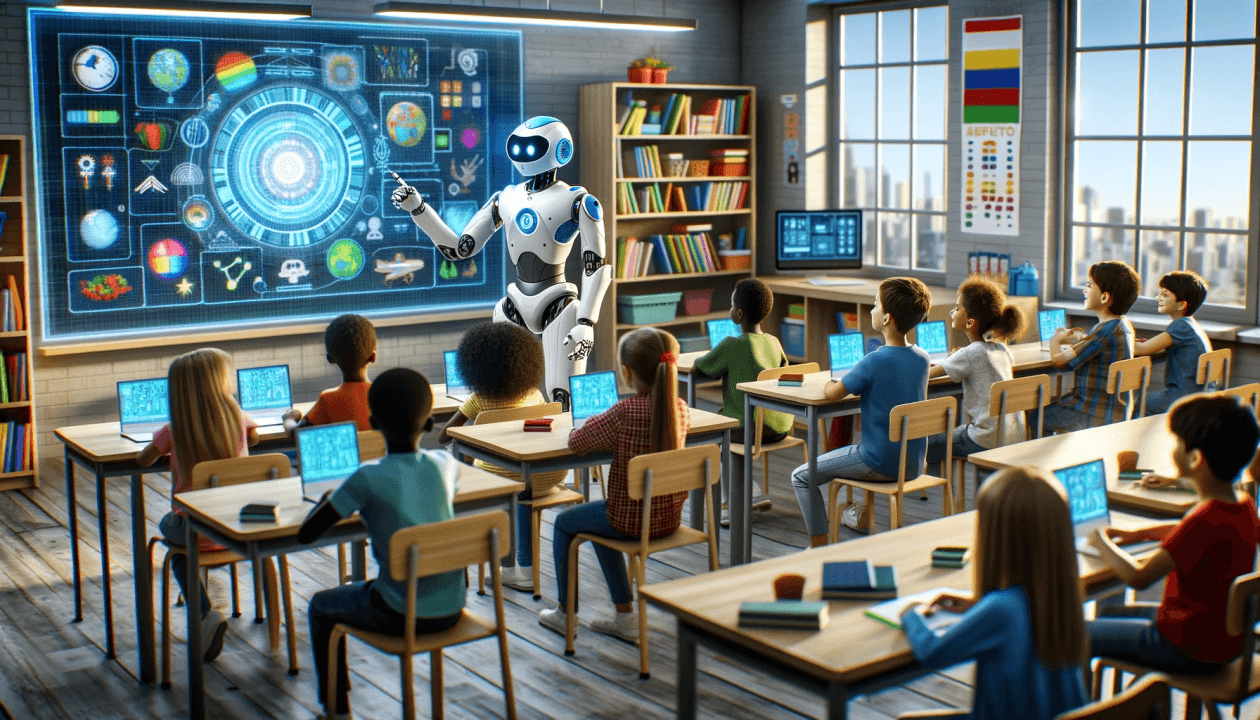
How Schools in Yelahanka Are Integrating AI and Robotics in Early Education
Introduction
Education is undergoing a massive transformation, and schools in Yelahanka are leading the way by integrating Artificial Intelligence (AI) and robotics into early education. These advanced technologies are making learning interactive, engaging, and skill-focused, preparing students for a technology-driven future.
Why AI and Robotics Are Important in Early Education
Traditional teaching methods often fail to engage young learners effectively. AI and robotics offer:
✅ Personalized Learning – AI adapts lessons based on a student’s pace and understanding.
✅ Critical Thinking Development – Robotics fosters problem-solving and analytical skills.
✅ Real-World Applications – Students learn through hands-on experiences.
✅ Improved Engagement – AI-based lessons use animations, games, and simulations.
✅ Career Readiness – Early exposure to AI and robotics prepares students for future jobs.
How Schools in Yelahanka Are Using AI and Robotics
AI-Powered Smart Classrooms
Many schools in Yelahanka have introduced AI-driven smart classrooms featuring:
- AI-Powered Interactive Boards – These display animated lessons to keep students engaged.
- AI Virtual Assistants – Answer student queries instantly.
- Adaptive Learning Apps – Modify difficulty levels based on student performance.
Dedicated Robotics Labs
Robotics labs help students explore technology hands-on. Schools have introduced:
- DIY Robotic Kits – Allow students to build and program robots.
- Coding Classes – Teach students to write simple programs.
- AI-Driven Problem-Solving Activities – Encourage logical thinking and creativity.
AI in STEM Education
STEM (Science, Technology, Engineering, and Mathematics) subjects are more effective and engaging with AI-powered tools such as:
- Virtual Labs – Help students visualize experiments.
- AI Simulations – Explain complex concepts using real-world scenarios.
- Coding Platforms – Introduce students to Python, Scratch, and AI programming.
AI Tutors and Chatbots
AI-powered tutors and chatbots are enhancing learning beyond classrooms:
- Instant Homework Assistance – Students get answers to common queries.
- Personalized Learning Plans – AI tracks student progress and adjusts content accordingly.
- Speech Recognition AI – Helps in language learning and pronunciation improvement.
AI-Based Assessments
AI-driven assessments provide real-time insights into student performance:
- Instant Feedback – AI evaluates student responses and suggests improvements.
- Automated Test Grading – Saves teachers’ time by grading multiple-choice and written responses.
- Progress Tracking – AI creates reports on student strengths and weaknesses.
Benefits of AI and Robotics in Schools in Yelahanka
Engaging and Interactive Learning
✅ AI-powered tools make learning fun and engaging.
✅ Story-based and gamified content captures students’ interest.
✅ Robotics projects encourage collaborative learning.
Better Retention and Concept Clarity
✅ Visual explanations improve knowledge retention.
✅ Robotics-based experiments reinforce STEM concepts.
Enhanced Problem-Solving and Creativity
✅ Logical reasoning and coding are introduced early.
✅ Robotics projects encourage innovative thinking.
Improved Teacher Support
✅ AI-powered tools help teachers track and customize learning.
✅ Automated grading reduces workload.
Challenges in Implementing AI and Robotics in Schools
High Costs of Technology
Setting up AI-powered classrooms and robotics labs requires funding. Schools are addressing this through:
- Government Grants – Supporting digital transformation in education.
- Corporate Partnerships – Collaborating with tech firms for AI integration.
Need for Teacher Training
Teachers need specialized skills to teach AI and robotics. Solutions include:
- AI Training Workshops – Educators learn hands-on AI applications.
- Online AI Certification Programs – Schools encourage teachers to upskill.
Data Privacy Concerns
AI collects student learning data, raising privacy concerns. Schools are ensuring:
- Strict Data Protection Policies – Encryption and restricted access to student data.
- Compliance with Data Privacy Regulations – Secure AI implementations in schools.
Future of AI and Robotics in Schools in Yelahanka
Looking ahead, schools in Yelahanka will:
✅ Expand AI-based personalized learning systems.
✅ Introduce AI-powered career counseling for students.
✅ Implement AI-assisted extracurricular programs.
✅ Strengthen robotics competitions and innovation programs.
FAQs
1. How are AI and robotics improving early education in Yelahanka?
Ans - They make learning more interactive, personalized, and engaging, helping students develop skills like problem-solving and logical thinking.
2. Are AI and robotics expensive for schools?
Ans - Yes, but grants and corporate partnerships are making AI adoption more affordable for schools.
3. Do teachers need special training to teach AI?
Ans - Yes, many schools provide AI and robotics workshops to help teachers adapt to the new curriculum.
4. Will AI replace human teachers?
Ans - No, AI assists teachers in personalizing learning, but human interaction remains essential in education.
5. How does robotics help students in early education?
Ans - Robotics develops creativity, problem-solving skills, and coding knowledge, preparing students for future careers.
6. What is the future of AI in education?
Ans - AI will revolutionize assessments, career guidance, and adaptive learning, making education more efficient and engaging.
Conclusion
AI and robotics are reshaping early education, ensuring students receive future-ready learning experiences. Schools in Yelahanka are at the forefront of this transformation, leveraging AI-powered classrooms, robotics labs, and smart learning platforms. As advancements continue, AI-integrated education will become the standard, preparing students for the digital world.

How Schools in Yelahanka Are Integrating AI and Robotics in Early Education
Introduction
Education is undergoing a massive transformation, and schools in Yelahanka are leading the way by integrating Artificial Intelligence (AI) and robotics into early education. These advanced technologies are making learning interactive, engaging, and skill-focused, preparing students for a technology-driven future.
Why AI and Robotics Are Important in Early Education
Traditional teaching methods often fail to engage young learners effectively. AI and robotics offer:
✅ Personalized Learning – AI adapts lessons based on a student’s pace and understanding.
✅ Critical Thinking Development – Robotics fosters problem-solving and analytical skills.
✅ Real-World Applications – Students learn through hands-on experiences.
✅ Improved Engagement – AI-based lessons use animations, games, and simulations.
✅ Career Readiness – Early exposure to AI and robotics prepares students for future jobs.
How Schools in Yelahanka Are Using AI and Robotics
AI-Powered Smart Classrooms
Many schools in Yelahanka have introduced AI-driven smart classrooms featuring:
- AI-Powered Interactive Boards – These display animated lessons to keep students engaged.
- AI Virtual Assistants – Answer student queries instantly.
- Adaptive Learning Apps – Modify difficulty levels based on student performance.
Dedicated Robotics Labs
Robotics labs help students explore technology hands-on. Schools have introduced:
- DIY Robotic Kits – Allow students to build and program robots.
- Coding Classes – Teach students to write simple programs.
- AI-Driven Problem-Solving Activities – Encourage logical thinking and creativity.
AI in STEM Education
STEM (Science, Technology, Engineering, and Mathematics) subjects are more effective and engaging with AI-powered tools such as:
- Virtual Labs – Help students visualize experiments.
- AI Simulations – Explain complex concepts using real-world scenarios.
- Coding Platforms – Introduce students to Python, Scratch, and AI programming.
AI Tutors and Chatbots
AI-powered tutors and chatbots are enhancing learning beyond classrooms:
- Instant Homework Assistance – Students get answers to common queries.
- Personalized Learning Plans – AI tracks student progress and adjusts content accordingly.
- Speech Recognition AI – Helps in language learning and pronunciation improvement.
AI-Based Assessments
AI-driven assessments provide real-time insights into student performance:
- Instant Feedback – AI evaluates student responses and suggests improvements.
- Automated Test Grading – Saves teachers’ time by grading multiple-choice and written responses.
- Progress Tracking – AI creates reports on student strengths and weaknesses.
Benefits of AI and Robotics in Schools in Yelahanka
Engaging and Interactive Learning
✅ AI-powered tools make learning fun and engaging.
✅ Story-based and gamified content captures students’ interest.
✅ Robotics projects encourage collaborative learning.
Better Retention and Concept Clarity
✅ Visual explanations improve knowledge retention.
✅ Robotics-based experiments reinforce STEM concepts.
Enhanced Problem-Solving and Creativity
✅ Logical reasoning and coding are introduced early.
✅ Robotics projects encourage innovative thinking.
Improved Teacher Support
✅ AI-powered tools help teachers track and customize learning.
✅ Automated grading reduces workload.
Challenges in Implementing AI and Robotics in Schools
High Costs of Technology
Setting up AI-powered classrooms and robotics labs requires funding. Schools are addressing this through:
- Government Grants – Supporting digital transformation in education.
- Corporate Partnerships – Collaborating with tech firms for AI integration.
Need for Teacher Training
Teachers need specialized skills to teach AI and robotics. Solutions include:
- AI Training Workshops – Educators learn hands-on AI applications.
- Online AI Certification Programs – Schools encourage teachers to upskill.
Data Privacy Concerns
AI collects student learning data, raising privacy concerns. Schools are ensuring:
- Strict Data Protection Policies – Encryption and restricted access to student data.
- Compliance with Data Privacy Regulations – Secure AI implementations in schools.
Future of AI and Robotics in Schools in Yelahanka
Looking ahead, schools in Yelahanka will:
✅ Expand AI-based personalized learning systems.
✅ Introduce AI-powered career counseling for students.
✅ Implement AI-assisted extracurricular programs.
✅ Strengthen robotics competitions and innovation programs.
FAQs
1. How are AI and robotics improving early education in Yelahanka?
Ans - They make learning more interactive, personalized, and engaging, helping students develop skills like problem-solving and logical thinking.
2. Are AI and robotics expensive for schools?
Ans - Yes, but grants and corporate partnerships are making AI adoption more affordable for schools.
3. Do teachers need special training to teach AI?
Ans - Yes, many schools provide AI and robotics workshops to help teachers adapt to the new curriculum.
4. Will AI replace human teachers?
Ans - No, AI assists teachers in personalizing learning, but human interaction remains essential in education.
5. How does robotics help students in early education?
Ans - Robotics develops creativity, problem-solving skills, and coding knowledge, preparing students for future careers.
6. What is the future of AI in education?
Ans - AI will revolutionize assessments, career guidance, and adaptive learning, making education more efficient and engaging.
Conclusion
AI and robotics are reshaping early education, ensuring students receive future-ready learning experiences. Schools in Yelahanka are at the forefront of this transformation, leveraging AI-powered classrooms, robotics labs, and smart learning platforms. As advancements continue, AI-integrated education will become the standard, preparing students for the digital world.
